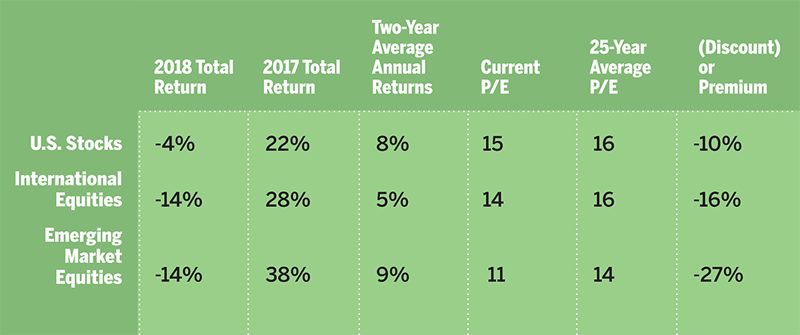In the long term, the market's fundamentals win out over investor sentiment. That's a good thing to remember.
By Bob Killebrew, Senior Strategist
One of investing guru Benjamin Graham’s many insights is that in the short term the market is a voting machine, but in the long run it is a weighing machine. The “voting” in this analogy is the current mood of the investing public, which swings from overly depressed to irrationally exuberant. The “weighing” is the math of the long-term fundamentals of investments—which eventually become quite rational. Remembering the supremacy of math over mood is key to navigating a choppy market like the one we are in now.
First, the Mood
Imagine you are on an airplane and the aircraft begins to shake with turbulence. Even though you know the statistics that flying is safer than driving, you begin to worry. Then the pilot comes on to say that planes ahead of you report that the turbulence will be over in a few minutes. You relax when you are reassured that disaster is not looming.
With a market that yo-yos this much—the S&P 500 was down 20% from Oct. 3 to Dec. 24 and then up 10% from then through Jan. 14—it no doubt feels like a bumpy flight. Turbulence is more common than you might think. Since 1979, the stock market declines an average of 14% from its high to its low each calendar year, using the S&P 500. So the 20% decline in the fall was no fun but it is not far from normal.
The next time you hear that the market is down 500 points that day, remember that 500 points on the basis of 24,000 for the Dow Jones Industrial Average is only about a 2% move. To put that in context, imagine you owned an $80 stock and it went down to $78.40. You probably wouldn’t be panicked. Such movements are simply the normal volatility that is the oxygen that allows stocks to grow over time.
When whole markets plummet, though, it is natural for us to recall the nightmare of 2008-09, when stocks were down 57% at one point. But in 2009 the entire financial system was on the verge of collapse. Today, financial institutions have dramatically better balance sheets and there is nothing like the mortgage crisis on the horizon.
All that said, there are valid reasons for concern today, as there always are. The Fed is raising interest rates, slowing the economy at the same time as the economic stimulus from last year’s tax cut in the U.S. is waning. Then there’s the geopolitical risks coming from Washington, such as the government shutdown and the President’s protectionist trade talk regarding China. But in total, there’s nothing out there that warrants panic at this point.
Now, the Math
The good news is that the math behind the markets is pretty sound. While the global economy is growing a little less rapidly, it is still expanding at a healthy rate. Unemployment in the U.S. is very low (3.9%) and wages are growing. Inflation is about 2% and not out of control. Earnings on the S&P 500 are expected to rise around 8% this year, which is slightly better than the long-term growth rate of 6%. The S&P’s current price/earnings ratio of less than 15 (using this year’s earnings estimate) is about a 10% discount to the average multiple of 16 over the last 25 years— meaning, stocks are a little cheaper than usual. Finally, remember that performance has not been too bad. The S&P was down 4% in 2018, but for the two years of 2017- 18, it returned 8%, while international stocks were up 5% and emerging markets stocks up 9%.

Source: JP Morgan
In sum, it seems that stocks are likely to have better results than bonds going forward, but they are unlikely to match the impressive returns of the past 10 years. In addition, what gains they do notch will likely be accompanied by more volatility. To prepare portfolios for this environment, we are focusing on quality in our equity managers. We are also emphasizing international and emerging market equities, which are even more attractively priced than U.S. stocks. We continue to seek out compelling private investments that sacrifice some liquidity to achieve higher returns and additional diversification. Finally, we are making sure clients are holding enough cash to withstand the higher volatility. That, and remembering that math eventually trumps mood, should make the ride a little more comfortable for you, too.
PLEASE SEE OUR IMPORTANT DISCLOSURES


